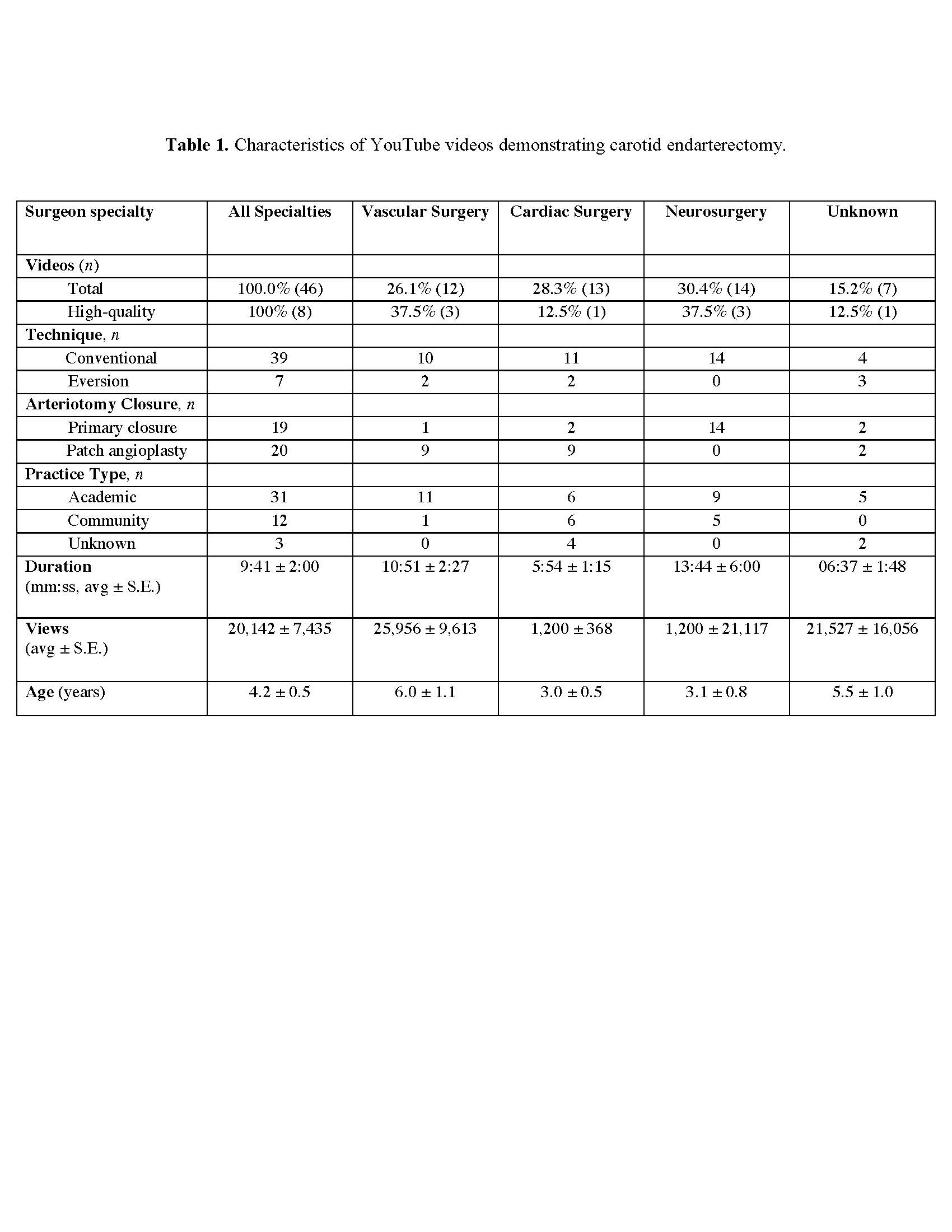Vascular Surgery Representation in Carotid Endarterectomy YouTube Videos
Jack E Doenges, Amy B Reed
University of Minnesota, Minneapolis, MN
INTRODUCTION: YouTube videos have become a common resource for trainees to learn about surgical procedures. Carotid endarterectomy (CEA) is one example of a procedure on YouTube by multiple specialties with a variety of techniques. We compared the educational quality of these videos, techniques, and prevalence of each specialty. METHODS: YouTube was programmatically searched for the terms “carotid endarterectomy,” “carotid endarterectomy surgery,” “carotid endarterectomy technique,” “carotid endarterectomy CEA,” and “carotid artery surgery.” Videos longer than one minute with a resolution > 480 x 360 pixels (360p) that demonstrated some or all steps of CEA were analyzed for surgical technique, arteriotomy closure method, procedural steps, surgeon specialty, video length, and publication date. High-quality videos were defined as those with English language captions or narration explaining anatomic landmarks and those that demonstrated key steps of the procedure: division of the common facial vein, exposure of the common, external, and internal carotid arteries, vascular control and clamping, arteriotomy, endarterectomy, and arteriotomy closure. Industry videos, animations, and simulated procedures were excluded. RESULTS: Forty-six videos met inclusion criteria and were published between July 2007 and February 2019. Vascular surgery was associated with 26.1% (12) of CEA videos, cardiac surgery with 28.3% (13), and neurosurgery with 30.4% (14). Surgeon specialty was unknown for 17.4% (7) of videos. Eight videos were high-quality, of which vascular surgery was associated with 37.5% (n = 3). Conventional endarterectomy was the most common technique demonstrated while a total of seven videos demonstrated eversion technique. Vascular and cardiac surgeons were more likely to demonstrate patch angioplasty than neurosurgeons, who exclusively performed primary closure (p< 0.05). Compared to cardiac surgeons, vascular surgeon CEA videos had more views (25,956 ± 9,613vs. 1,200 ± 368,p < 0.05) and were more likely to be published by user accounts with an academic affiliation (11 vs. 6, p< 0.05). Vascular surgery videos were older than videos by cardiac surgeons (6.0 ± 1.1 y vs. 3.0 ± 0.5 y, p< 0.05)and neurosurgeons (6.0 ± 1.1 y vs. 3.1 ± 0.8 y, p< 0.05). (Table 1) No significant difference in video duration across specialties was found. CONCLUSIONS: Despite more views, the field of vascular surgery is underrepresented in YouTube videos demonstrating carotid endarterectomy. Vascular surgery videos tend to be older and make up a minority of high-quality videos. As more learners turn to YouTube for information about surgical procedures, vascular surgeons should expand their online presence in high-quality videos for trainees. 
Back to 2020 Posters
